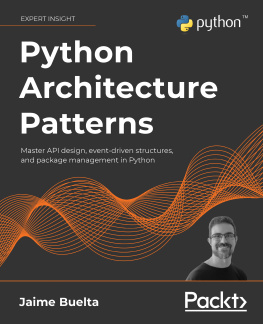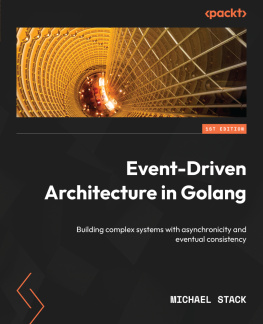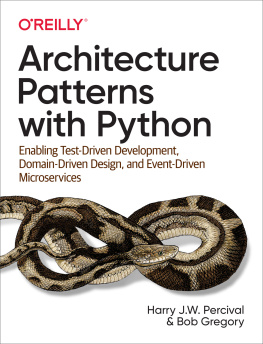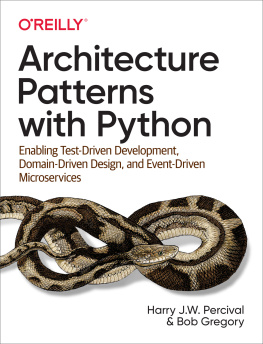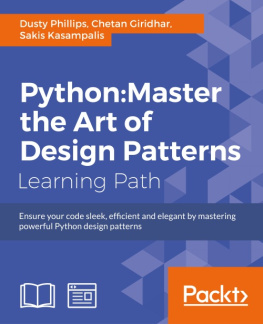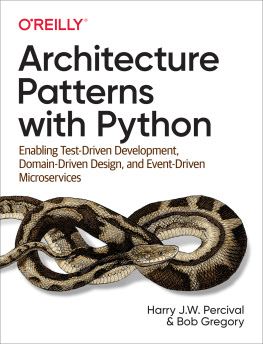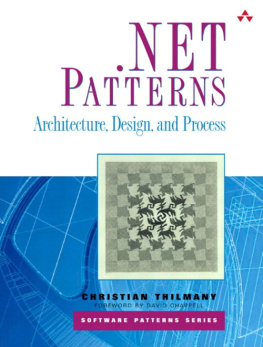Jaime Buelta - Python Architecture Patterns: Master API design, event-driven structures, and package management in Python
Here you can read online Jaime Buelta - Python Architecture Patterns: Master API design, event-driven structures, and package management in Python full text of the book (entire story) in english for free. Download pdf and epub, get meaning, cover and reviews about this ebook. year: 2022, publisher: Packt Publishing, genre: Computer. Description of the work, (preface) as well as reviews are available. Best literature library LitArk.com created for fans of good reading and offers a wide selection of genres:
Romance novel
Science fiction
Adventure
Detective
Science
History
Home and family
Prose
Art
Politics
Computer
Non-fiction
Religion
Business
Children
Humor
Choose a favorite category and find really read worthwhile books. Enjoy immersion in the world of imagination, feel the emotions of the characters or learn something new for yourself, make an fascinating discovery.
- Book:Python Architecture Patterns: Master API design, event-driven structures, and package management in Python
- Author:
- Publisher:Packt Publishing
- Genre:
- Year:2022
- Rating:3 / 5
- Favourites:Add to favourites
- Your mark:
Python Architecture Patterns: Master API design, event-driven structures, and package management in Python: summary, description and annotation
We offer to read an annotation, description, summary or preface (depends on what the author of the book "Python Architecture Patterns: Master API design, event-driven structures, and package management in Python" wrote himself). If you haven't found the necessary information about the book — write in the comments, we will try to find it.
Make the best of your test suites by using cutting-edge software architecture patterns in Python
Key Features- Learn how to create scalable and maintainable applications
- Build a web system for micro messaging using concepts in the book
- Use profiling to find bottlenecks and improve the speed of the system
Developing large-scale systems that continuously grow in scale and complexity requires a thorough understanding of how software projects should be implemented. Software developers, architects, and technical management teams rely on high-level software design patterns such as microservices architecture, event-driven architecture, and the strategic patterns prescribed by domain-driven design (DDD) to make their work easier.
This book covers these proven architecture design patterns with a forward-looking approach to help Python developers manage application complexityand get the most value out of their test suites.
Starting with the initial stages of design, you will learn about the main blocks and mental flow to use at the start of a project. The book covers various architectural patterns like microservices, web services, and event-driven structures and how to choose the one best suited to your project. Establishing a foundation of required concepts, you will progress into development, debugging, and testing to produce high-quality code that is ready for deployment. You will learn about ongoing operations on how to continue the task after the system is deployed to end users, as the software development lifecycle is never finished.
By the end of this Python book, you will have developed architectural thinking: a different way of approaching software design, including making changes to ongoing systems.
What you will learn- Think like an architect, analyzing software architecture patterns
- Explore API design, data storage, and data representation methods
- Investigate the nuances of common architectural structures
- Utilize and interoperate elements of patterns such as microservices
- Implement test-driven development to perform quality code testing
- Recognize chunks of code that can be restructured as packages
- Maintain backward compatibility and deploy iterative changes
This book will help software developers and architects understand the structure of large complex systems and adopt architectural patterns that are scalable. Examples in the book are implemented in Python so a fair grasp of basic Python concepts is expected. Proficiency in any programming languages such as Java or JavaScript is sufficient.
Table of Contents- Introduction to Software Architecture
- API Design
- Data Modeling
- The Data Layer
- The Twelve-Factor App Methodology
- Web Server Structures
- Event-Driven Structures
- Advanced Event-Driven Structures
- Microservices vs Monolith
- Testing and TDD
- Package Management
- Logging
- Metrics
- Profiling
- Debugging
- Ongoing Architecture
Jaime Buelta: author's other books
Who wrote Python Architecture Patterns: Master API design, event-driven structures, and package management in Python? Find out the surname, the name of the author of the book and a list of all author's works by series.

